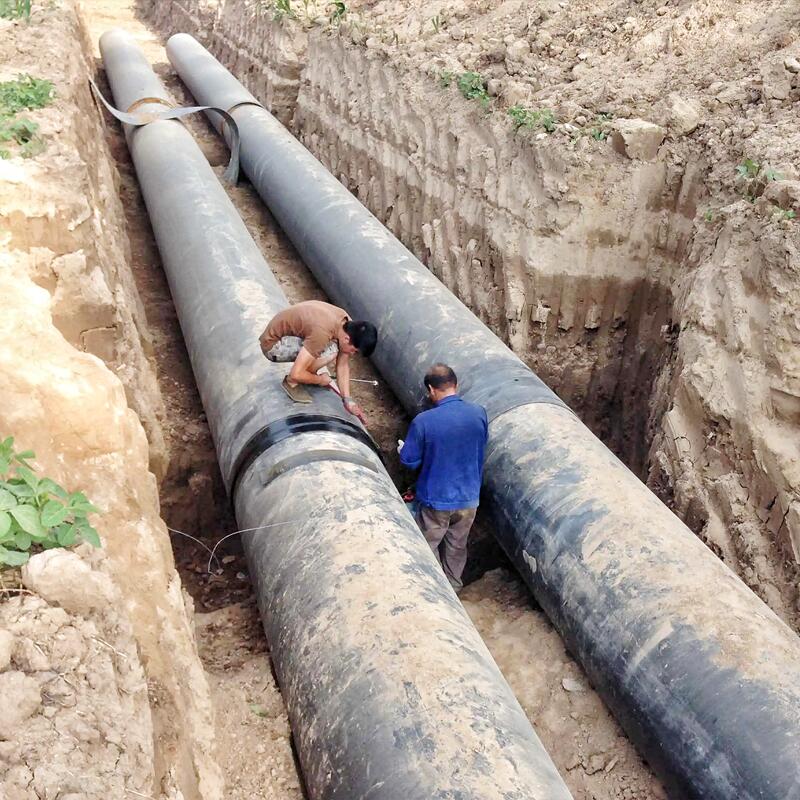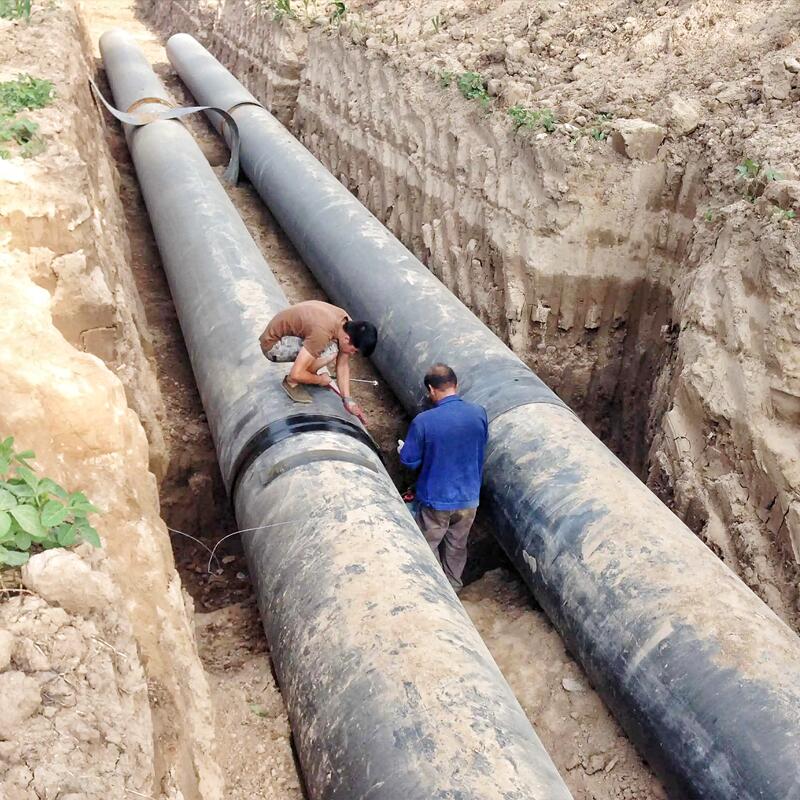1. Preparing for installation of polyethylene pipes
(1) Polyethylene pipe fittings and pipes may be deformed and deteriorated due to poor transportation, loading and unloading, stacking or covering or long storage. It is necessary to conduct an appearance quality inspection before connecting.
(2) Polyethylene pipes should be connected by hot-melt connection (hot-melt butt connection, hot-melt socket connection, hot-melt saddle connection), and screw connection and bonding shall not be used. Polyethylene pipes and metal pipes and valves must be connected by steel-plastic conversion and electrofusion connection.
(3) There should be corresponding special connection tools for different connection forms of polyethylene pipes. When connecting, do not use an open flame to heat.
(4) The pipes and fittings of the same grade and material are used when the polyethylene pipes are connected by hot melt welding. The connection between pipes of different grades and materials with similar performance and pipes or fittings shall be carried out only after it is judged that the quality of the connection can be guaranteed.
(5) Before taking up the job, the workers who operate the connection of polyethylene pipes should go through special training.
(6) When the temperature difference between the storage of polyethylene pipes and fittings and the construction site is large, the pipes and fittings should be placed on the construction site for a period of time. Make its temperature close to the construction site temperature.
(7) When connecting polyethylene pipes, the pipe ends should be clean. Each time the work is finished, the nozzle should be temporarily blocked.
(8) After the polyethylene pipe connection is completed, the appearance quality inspection of the joint should be carried out. Those who fail must rework the joint appearance and quality inspection.

2. How to install polyethylene pipe?
(1) The PE pipe connection should adopt automatic electric fusion and automatic hot-melt butt joint, and all hot-melt connections should use qualified automatic hot-melt welding machine, and carry out the crimping test. If the thermal fusion welding machine selected by the contractor is not a product recommended by the developer's purchase list, the performance description of the welding machine shall be provided to the developer for evaluation.
(2) The PE pipes/fittings of different grades and SDRs can only be connected by electrofusion.
(3) Fittings or pipe sections that have undergone a complete heating cycle shall not be reheated.
(4) When PE electrofusion is connected, it must be ensured that the socket at the end of the pipe is pushed to the center of the pipe fitting. Electrofusion fixtures must be used during electrofusion welding to check the alignment and centering of the joint to reduce tube out-of-roundness, offset, and movement during the joining and cooling stages.
(5) It is strictly forbidden to operate the electric fusion control box and generator in the environment with gas.
(6) Before and after the hot-melt connection, the dirt on the heating surface of the connection tool should be wiped off with a clean cotton cloth.
(7) The hot melt butt connection is generally divided into five stages: preheating stage, endothermic stage, heating plate removal stage, docking stage, and cooling stage.
(8) The three important parameters of the hot-melt connection process: temperature, pressure, and time should comply with the regulations of the hot-melt connection equipment manufacturer for pipes and pipe fittings.
(9) For hot melt butt welding, the pipes or fittings are required to have the same melt index, and preferably the same SDR value. In addition, when using pipe fittings from different manufacturers, a reasonable matching welding machine must be selected to achieve the best welding effect.
(10) The pressure holding and cooling time of the hot-melt connection shall comply with the regulations of the hot-melt connection tool manufacturer and the pipe fitting and pipe manufacturer to ensure that the connecting piece shall not be moved or external force applied to the connecting piece during cooling.
(11) The polyethylene pipe is light and soft, and it is convenient to handle and lower the pipe to the pipe trench. It should be connected on the trench, so the width of the trench bottom is set according to the welding requirements on the steel pipe trench. When a single-pipe trench is assembled and laid, the width of the trench bottom is the nominal outer diameter of the pipe plus 0.3m.
(12) The polyethylene pipe is relatively soft. When the pipe is bent, the pipe itself can be bent without adding another bend. When laying polyethylene pipes, the allowable bending radius of the pipes shall meet the requirements in the following table.
(13) When the polyethylene pipe changes direction and bends with the pipe itself, the trench should be excavated according to the bending radius of the pipe. When the local environment does not permit, use the elbow in the polyethylene pipe fittings.
(14) According to the length of each polyethylene pipe, a working pit for the joint should be dug before the pipe is lowered, so as to be used for welding in the trench, strength and tightness test inspection. The interface work pit is slightly smaller than the metal pipe interface work pit. When there is an error in the working pit after the pipe is lowered, it should be trimmed to prevent damage to the pipe.
(15) Polyethylene pipes should be laid only after the ditch bottom elevation and the quality of the pipe foundation have passed the inspection. The lowering method adopts manual method. Commonly used rope pressing method, manual lifting and placing, etc.
(16) When laying polyethylene pipes, metal tracer lines must be buried along the direction of the pipes. The metal tracer lines should be laid close to the top surface of the polyethylene pipes and fixed with adhesive tape at certain distances; Less than 300mm outside buried protection board and ordinary warning tape. The tracer line is buried for the convenience of pipeline positioning. Accurately delineate the walkway of polyethylene pipes.
(17) After the pipeline is laid, leave the interface to be inspected (strength and tightness test), and partially backfill the pipe body to avoid external damage to the pipeline.
3. Butt connection of hot melt polyethylene pipe on request
1) Before the butt connection, the two polyethylene pipe sections each extend out of the fixture for a certain free length, and the two corresponding connectors should be straightened so that they are on the same axis, and the wrong side should not be greater than 10% of the wall thickness.
2) The dirt on the connecting surface of pipes or fittings should be wiped off with a clean cotton cloth, and the connecting surface should be milled so that it is perpendicular to the axis and matched with the corresponding end face.
3) The end face of the equal connection is heated with a butt connection tool, and the constant temperature of the flat plate electric heating mold is 210±10℃.
4) After the heating is completed, the parts to be connected should be quickly disengaged from the butt connection. The heating tool should be applied with a uniform external force to make the end face fully contact, maintain the specified pressure and time, and wait for the interface to cool to normal temperature naturally.
4. The polyethylene pipe connection process is automatically controlled by an automatic welding machine.
1) Requirements for hot melt socket connection polyethylene pipe
The connecting end of the hot-melt socket connection polyethylene pipe should be cut vertically, and the dirt on the connecting surface of the pipe and the pipe fitting should be wiped off with a clean cotton cloth, the insertion depth should be marked, and the skin should be scraped off.
Before the socket and socket connection, the two corresponding parts to be connected should be straightened so that they are on the same axis.
The outer surface of the socket and the inner surface of the socket shall be heated with a hot melt socket connection tool.
After the heating is completed, the parts to be connected should be quickly separated from the connecting tool, and should be inserted into the marked depth with a uniform external force, and the pressure should be maintained until the interface drops to normal temperature, so that the polyethylene molecules can diffuse each other and be fully combined.
2) Steel-plastic conversion connection
When connecting polyethylene pipes converted from steel to plastics, the connection between the ends and the polyethylene pipes shall comply with the corresponding electrofusion connection regulations in this Regulation.
The connection between the end of the steel-plastic conversion pipe and the metal pipe shall comply with the corresponding regulations on steel pipe welding, flange connection or mechanical connection.
Cooling measures should be taken when the steel-plastic conversion steel pipe is welded with the steel pipe.
5、How to Install Flexible Polyethylene Pipe
The polyethylene pipe is relatively soft, and when the pipe is bent, the pipe itself can be bent without the need for additional bends. When laying polyethylene pipes, the allowable bending radius of the pipes shall meet the requirements in the following table.
1) When there is no socket joint on the pipe section, it should meet the requirements of the following table:
Pipe Allowable Bending Radius(mm)
Pipe Nominal Outside Diameter D | Allowable bending radius R |
D≤50 | 30D |
50<D≤160 | 50D |
160<D≤250 | 75D |
2) When there is a socket joint on the pipe section, it should not be less than 125D
How to install polyethylene hose is also very easy?
How to inspect polyethylene pipe?
1. What are the requirements for the inspection of PE pipe electrofusion interface?
There shall be no scratches on the entire circumference of the pipes at both ends of the pipe fittings, and there shall be no grease and contaminants on the outer diameter of the pipe;
The melt in the fusion process does not seep out of the accessories;
The pipe fittings are in the center of the pipeline positioning lines on both sides;
The fusion display needle (if there is such a device) has been raised at least 2mm;
Pipe and fittings are already aligned.
2. What are the requirements for the inspection of the PE pipe hot melt interface?
Check that the curling edge is normal and uniform before cutting off the curling edge, and use a curling edge measuring device to measure its width within the allowable size range;
After cutting off the curling edge, use a curling edge measuring device to check that the width of the curling edge meets the specified "maximum/minimum" standard, and at the same time check that the curling edge is not deformed; it should be 100% edge cutting inspection;
Check the joint interface at the bottom of the crimp for inclusions and contamination. If found, check the corresponding position of the pipe interface to confirm that there is no same contamination;
Check that there are no cracks caused by insufficient fusion at the joint interface at the bottom of the curling;
Bend the hem back to verify that there is no lack of fusion. If there is a problem with the fusion, there will be visible cracks where there is insufficient fusion. If found, find the location of insufficient fusion on the pipe joint;
Check that the pipes at both ends are aligned in a straight line on the interface;
Hems shall be numbered and filed.
The above are the installation and inspection methods, requirements and procedures of polyethylene pipes. If there is still something unclear and clear, please contact our experts.









659.webp)
210.webp)
328.webp)

294.webp)
476.webp)


